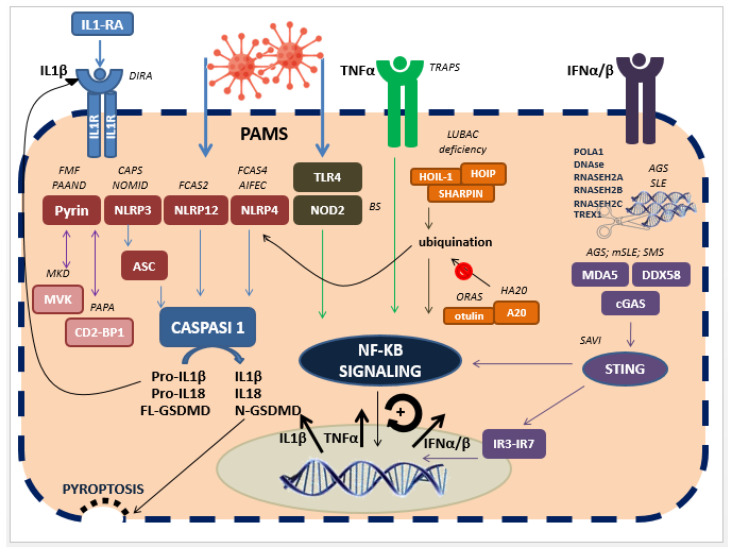Figure 1.
Inflammatory signalling pathways in AIDs. The first step of inflammatory response is the recognition of pathogens’ conserved structures (PAMP) by PPR of intracellular sensors (including NLR domains, ALR and pyrine), with the formation of a multimeric proteic complex, called inflammasome. The inflammasome receptors interact with the adapter protein ASC, leading to the activation of Caspase 1, which converts pro-IL-1β and pro-IL-18 to their bioactive forms. Caspase 1 also cleavages the Gasdermin-D (GSDMD), whose N-terminal domain (GSDMD-N) forms cytotoxic pores in the lipidic cellular membrane, causing pyroptosis. Also, PAMPs are sensed by TLRs (mainly TLR-4) or NOD2 receptors and activate NF-κB pathway, enhancing NLRP-3 transcription. The intra-cytoplasmic accumulation of viral or endogenous nucleic acids is sensed by others proteins, like cGAS, MDA5 and DDX58, which activate STING and therefore IR3-IR7 factors. These latter translocate to the nucleus, stimulating the transcription of type I IFN genes. STING also directly activates NFkB signalling. Most of the described signalling pathways activate NF-κB signalling, thus stimulating the transcription of NF-κB-dependent genes (NLRP3, pro-IL-β, pro-IL-18, and IL-6) and promoting a positive feedback effect. Alterations at different levels of this complex mechanism are associated with the development different AIDs. Abbreviations: PAMP (pathogen associated molecular patterns); PRR (pattern recognition receptors); NLR (Nucleotide-binding oligomerization domain (NOD)-like receptors); ALR (Absence in melanoma 2 (AIM2)-like receptors); NLRP-3 (NLR family pyrin domain containing 3); NF-κB (NF-kappaB); IFN (interferon); IRF (IFN regulatory factor); CGAS (cyclic GMP-AMP synthase); MDA5 (melanoma differentiation-associated protein 5; DDX58 (DExD/H box RNA helicase); STING (Stimulator of interferon genes).

